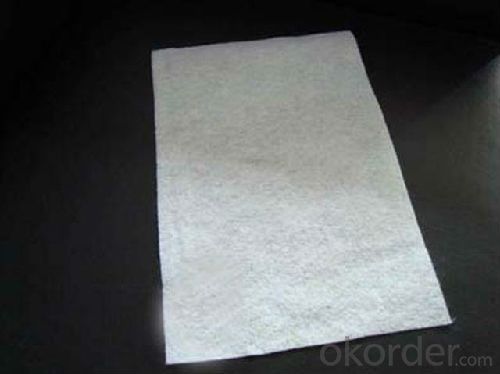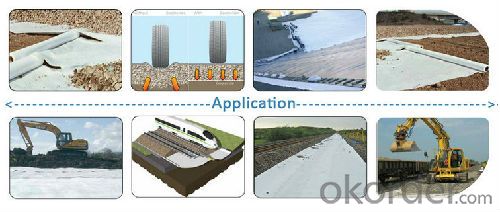Short Fiber and Geomembrane Composite Waterproofing Membrane
- Loading Port:
- Qingdao
- Payment Terms:
- TT or L/C
- Min Order Qty:
- 10000 m²
- Supply Capability:
- 10000 m²/month
OKorder Service Pledge
OKorder Financial Service
You Might Also Like
(1) Product introduction
Short fiber knitting geotextile takes the polypropylene fiber or the polyester fiber short fiber as the primary material, after blooms the pine ,to comb, disorderly, craft productions so on shop net, acupuncture to become.
(2) Product features
1. Net holes are easy foe blockage, since net structure formed by indefinite fiber has variable and motility.
2. It has high permeation and can keep good permeation under the pressure of earthwork.
3. It has corrosion resistance, uses chemical fiber such as polypropylene or Dacron as raw material, has acid and alkali resistance, hasn’t corrosion or moth-eaten and has oxidation resistance.
4. It has convenient construction, small weight and convenient uses.
Short fiber knitting geocloth | ||||||||||||
Specification | 100 | 150 | 200 | 250 | 300 | 350 | 400 | 450 | 500 | 600 | 800 | Remark |
Quality deviation per unit acreage % | -8 | -8 | -8 | -8 | -7 | -7 | -7 | -7 | -6 | -6 | -6 | |
Thickness, mm≥ | 0.9 | 1.3 | 1.7 | 2.1 | 2.4 | 2.7 | 3 | 3.3 | 3.6 | 4.1 | 5 | |
Width deviation for range, % m | -0.5 | |||||||||||
Mightiness at break, KN/M ≥ | 2.5 | 4.5 | 6.5 | 8.0 | 9.5 | 11.0 | 12.5 | 14.0 | 16.0 | 19.0 | 25.0 | Vertical and horizontal |
Elongation at break, % | 25-100 | Vertical and horizontal | ||||||||||
CBR bursting strengthk, KN ≥ | 0.3 | 0.6 | 0.9 | 1.2 | 1.5 | 1.8 | 2.1 | 2.4 | 2.7 | 3.2 | 4.0 | |
Effective aperture O90 | 0.07-0.20 | |||||||||||
Vertical osmotic coefficient,cm/s | K*(10-1-10-3) | K=1.0-9.9 | ||||||||||
Tearing strength, KN≥ | 0.08 | 0.12 | 0.16 | 0.2 | 0.24 | 0.28 | 0.33 | 0.38 | 0.42 | 0.46 | 0.6 | Vertical and horizontal |

FAQ
Q: What kind of payments does jenor support?
A: T/T, L/C, Cash are accepted.
Q: Do you charge for the samples?
A: Accordeing to our company policy, the samples are freee, we only charge the freight fee. And we will return the freight fee during the next order.
Q: Can you produce according to customers' design?
A: Sure, we are professional manufacturer, OEM and ODM are both welcome.


- Q:Can geotextiles be used in erosion control in stormwater detention ponds?
- Yes, geotextiles can be used in erosion control in stormwater detention ponds. These permeable fabrics can provide stabilization and reinforcement to the soil, preventing erosion and promoting efficient stormwater management in detention ponds. They can be installed as filters, liners, or erosion control blankets, effectively reducing sediment runoff and protecting the pond from erosion caused by heavy flows and wave action.
- Q:How do geotextiles help in preventing lateral spreading of soil?
- Geotextiles help in preventing lateral spreading of soil by acting as a barrier that stabilizes the soil and restricts its movement. These synthetic materials are placed between layers of soil to provide reinforcement and prevent the lateral displacement of soil particles. The geotextiles act as a separator, allowing water to pass through while retaining soil particles, thus reducing the potential for soil erosion and lateral spreading.
- Q:What are the different geotextile weight classes and their applications?
- Geotextiles are categorized into different weight classes based on their mass per unit area. These weight classes range from lightweight to heavyweight. Lightweight geotextiles, usually less than 200 grams per square meter (gsm), are commonly used in erosion control applications, such as slope stabilization and vegetation support. They provide filtration and separation functions while allowing water to pass through. Medium-weight geotextiles, typically ranging from 200 to 400 gsm, are often employed in applications like road stabilization, embankment reinforcement, and subgrade separation. They offer a balance between strength and permeability, ensuring proper drainage and preventing soil movement. Heavyweight geotextiles, exceeding 400 gsm, are primarily used in applications requiring high strength and durability. These include shoreline protection, coastal engineering, and land reclamation projects. They provide robust reinforcement and act as a barrier against erosion and wave action. The choice of geotextile weight class depends on the specific engineering requirements of the project, such as soil conditions, anticipated loads, and desired drainage characteristics.
- Q:300g geotextile GB thickness is how much
- There are a variety of geotextiles. If it is non-woven, then upstairs said correct. If it is woven type, that is not right, it should be about 1mm.
- Q:Are geotextiles suitable for use in high-temperature environments?
- Yes, geotextiles are suitable for use in high-temperature environments. Geotextiles are designed to withstand a wide range of temperatures, including high temperatures. They are often used in applications such as road construction, erosion control, and drainage systems in hot climates without any issues.
- Q:Can geotextiles be used in green roof construction?
- Yes, geotextiles can be used in green roof construction. Geotextiles are commonly used as a separation layer between the growing medium and the drainage layer in green roofs. They help prevent the migration of fine particles into the drainage layer and maintain proper water flow within the system. Additionally, geotextiles can enhance root penetration and overall stability of the green roof.
- Q:Where is the geotextile
- Permeable geotextile is generally used in the railway roadbed reinforcement, road maintenance, sports museum, dam protection, water structural isolation, then hole, coastal beach, reclamation, environmental protection, landscaping and other projects.
- Q:How do geotextiles help with pipeline protection?
- Geotextiles help with pipeline protection by acting as a barrier between the pipeline and the surrounding soil, preventing soil erosion and the formation of voids around the pipeline. They also provide additional support and reinforcement to the pipeline, reducing the risk of damage from external forces such as ground movement or heavy traffic. Furthermore, geotextiles can help with filtration, allowing water to pass through while preventing the migration of fine particles that could clog the pipeline. Overall, geotextiles enhance the longevity and structural integrity of pipelines, ensuring their safe and efficient operation.
- Q:How are geotextiles used in civil engineering projects?
- Geotextiles are commonly used in civil engineering projects for various purposes such as soil stabilization, erosion control, drainage management, and filtration. These synthetic fabrics are placed in the soil to reinforce it, prevent erosion, filter water, separate different layers of soil, and improve the overall performance and longevity of the project. They are versatile, cost-effective, and environmentally friendly solutions that help enhance the stability and functionality of civil engineering structures like roads, embankments, retaining walls, and landfills.
- Q:Are geotextiles resistant to fungal growth?
- Yes, geotextiles are generally resistant to fungal growth due to their synthetic nature and the materials they are made from.
1. Manufacturer Overview |
|
|---|---|
| Location | Taian City,Shandong Province,China |
| Year Established | 2008 |
| Annual Output Value | Above US$100 Million |
| Main Markets | Africa, Oceania, North America, Western Europe, Eastern Asia |
| Company Certifications | ISO9001;IS014001 Certificate |
2. Manufacturer Certificates |
|
|---|---|
| a) Certification Name | |
| Range | |
| Reference | |
| Validity Period | |
3. Manufacturer Capability |
|
|---|---|
| a)Trade Capacity | |
| Nearest Port | Qingdao Port;Tianjing Port;Shanghai Port |
| Export Percentage | |
| No.of Employees in Trade Department | 21-30 People |
| Language Spoken: | English; Chinese; |
| b)Factory Information | |
| Factory Size: | 10,000-30,000 square meters |
| No. of Production Lines | Above 10 |
| Contract Manufacturing | Geotechnical Material (Geogrid,Fiberglass/Polyester Geogrid,Geocell,Geonet and Geomat,Plastic Safety Fence) |
| Product Price Range | Average |
Send your message to us
Short Fiber and Geomembrane Composite Waterproofing Membrane
- Loading Port:
- Qingdao
- Payment Terms:
- TT or L/C
- Min Order Qty:
- 10000 m²
- Supply Capability:
- 10000 m²/month
OKorder Service Pledge
OKorder Financial Service
Similar products
New products
Hot products
Related keywords































